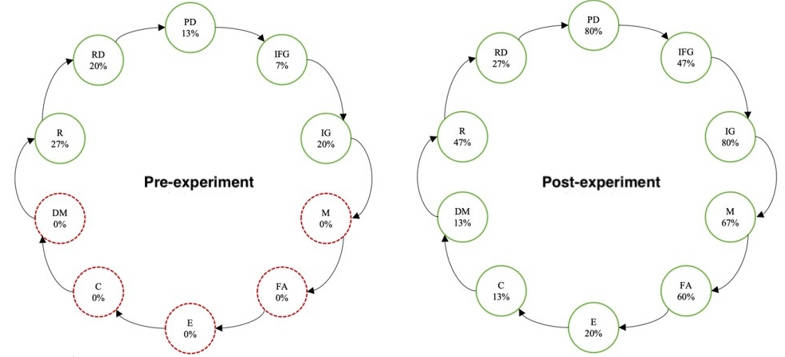(Provided by Professor Kuen-Yi Lin and his team from the Department of Technology Application and Human Resource Development)
The implementation of STEM education often overlooks the aspects of technology and engineering, leading to ongoing challenges in nurturing talent in these fields (Strimel & Grubbs, 2016). Addressing this issue, Song et al. (2016) and Brophy et al. (2008) suggest that planning technology-based learning activities with an emphasis on engineering design could effectively implement STEM education and enable students to engage in genuine interdisciplinary integration. Concerning the research on the cognitive structure of technology teachers in engineering design, disparities between engineering experts and novices may influence the focal points of technology teachers in the engineering design process. However, the cognitive structure of preservice technology teachers and their focal points in the engineering design process remain relatively underexplored and represent an important area for further investigation. This study primarily focused on exploring the cognitive structure of preservice middle school technology teachers in engineering design to understand their comprehension of engineering design thinking, and thereby identify the current status and issues regarding their cognitive structure in engineering design. Based on the data analysis of this study, the main research findings are as follows: (1) Preservice teachers who integrated engineering design thinking processes performed better in defining problems, generating ideas, modeling, and conducting feasibility analyses; (2) Preservice teachers engaging in STEM project-based activities should prioritize learning steps related to modeling and redesign to strengthen their abilities in complex and precision thinking.
In recent years, there has been significant attention given to the issues surrounding Science, Technology, Engineering, and Mathematics (STEM) education, particularly concerning the imperative of attracting a larger pool of talented individuals into the STEM fields (Holmes, Gore, Smith, & Lloyd, 2017). However, Strimel and Grubbs (2016) pointed out that the implementation of STEM education often neglects technology and engineering, leading to unresolved challenges in cultivating talent in these areas. Addressing this concern, Song et al. (2016) and Brophy et al. (2008) argued that planning technology-focused learning activities centered on engineering design could effectively implement STEM education, enabling students to truly engage in interdisciplinary integrated learning. While technology-focused learning activities centered on engineering design contribute to the implementation of STEM education, the extent to which teachers possess correct cognitive structure of engineering design when conducting such engineering design-oriented practical activities is a crucial research area worth exploring (Atman et al., 2007; Hannah, Joshi, & Summers, 2012).
In the realm of research concerning the cognitive structure of technology teachers in engineering design, the disparities between engineering experts and novices influence the focal points of technology teachers in the engineering design process. There is currently a lack of research on the cognitive structure of preservice technology teachers and their focal points in the engineering design process, making it an important topic for further exploration. This study focuses on investigating the cognitive structure of preservice middle school technology teachers in engineering design to understand their comprehension of engineering design thinking. By doing so, it aims to identify the current status and issues regarding the cognitive structure of preservice middle school technology teachers in engineering design, with the intention of assisting them in effectively integrating the engineering design process into technology-based activities when they enter the teaching profession. This is expected to help cultivate engineering design capabilities among more middle school students, thereby stimulating their interest in pursuing future careers in engineering-related fields.
Based on the data analysis of this study, the benefits of STEM project-based activities centered on the engineering design thinking processes are analyzed for preservice middle school technology teachers who received instruction emphasizing engineering design thinking processes (experimental group) versus those who received instruction focusing on technology problem-solving processes (control group). The findings from the instructional activities conducted by the researchers are as follows: (1) Preservice teachers who integrated engineering design thinking processes performed better in defining problems, generating ideas, modeling, and conducting feasibility analyses, indicating their superior engineering design thinking capabilities (see Figure 1); (2) Preservice teachers involved in STEM project-based activities should prioritize enhancing their skills in modeling and redesign stages to strengthen their abilities in complex and precision thinking.

Figure 1. Changes in the engineering design thinking of preservice teachers in the experimental group
Explanation 1: The circles represent different steps of engineering design thinking, with the percentage inside each circle indicating the proportion of preservice technology teachers who possess that particular thinking step. From the diagram, it is evident that before engineering design teaching, there were five missing engineering design thinking steps, all of which showed improvement after the experimental teaching.
Explanation 2: "PD" refers to Problem Definition, "IFG" to Information Gathering, "IG" to Idea Generation, "M" to Modeling, "FA" to Feasibility Analysis, "E" to Evaluation, "C" to Communication, "DM" to Decision Making, "R" to Realization, and "RD" to Redesign.
Although the instructional approach to the engineering design process currently emphasize complex computational methods, there are still many difficulties in implementation (Linder, 1999). Many teachers in the field find it challenging to execute, primarily citing insufficient time as a reason. Identifying common conceptual deficiencies among preservice middle school technology teachers before class and incorporating additional elements of engineering design thinking instruction would undoubtedly enhance teaching effectiveness without significantly increasing time spent on trial-and-error processes. Engineering design activities can effectively enhance preservice middle school technology teachers' ability to solve real-world problems and to practice and improve their skills and knowledge integration (Cardella et al., 2002; Woods, 1995).
Source:
Lin, K. Y., Wu, Y. T., Hsu, Y. T., & Williams, P. J. (2021). Effects of infusing the engineering design process into STEM project-based learning to develop preservice technology teachers’ engineering design thinking. International Journal of STEM Education, 8(1), 1-15. https://doi.org/10.1186/s40594-020-00258-9
Note: This article has been acknowledged on the cover page of the International Journal of STEM Education and ranks second in terms of citation frequency for the years 2021-2022.











